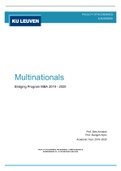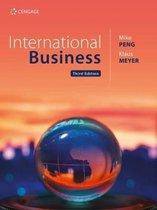FACULTY OF ECONOMICS
& BUSINESS
Multinationals
Bridging Program MBA 2019 - 2020
Prof. Sels Annabel
Prof. Slangen Arjen
Academic Year: 2019–2020
FACULTY OF ECONOMICS AND BUSINESS - CAMPUS BRUSSELS
WARMOESBERG 26 – B 1000 BRUSSELS BELGIUM
,MULTINATIONALS
COURSE CONTENT
Chapter 1: Globalizing business
Chapter 2: Formal institutions: Political, economic and legal systems
Chapter 3: Informal institutions
Chapter 4: Identifying and assessing firm resources
Chapters 6 and 11: FDI and theories of internationalization
Chapters 12 and 15: Foreign entry strategies and multinational strategies
Chapters 13 and 14: Competitive dynamics and Cross border Mergers and Acquisitions
CASES
• Adidas: sales, suppliers and stakeholders around the world
• Coca-Cola Dives into Africa
• Managing business risks in Turkey – impact of formal institutions on doing business in Turkey
• Managing business in South Africa after 1994
• Carlsberg faces political risk in Russia
• REPSOL case
• SAP drives industry 4.0
• Kaspersky
• Gulf Airlines challenge a global industry
• Brussels vs Microsoft and Google
• Danisco: the rise and sale of a global leader
• Daimler merges and demerges
• Kärcher
EXAM INFORMATION
50% Multiple choice questions (no guessing correction) + open questions
• Unformal constraints values will take over
• Which of the following statement is a synergy effect
• Offshore & outsourcing (difference)
• Original equipment & design manufacturing
2h30 duration
Structure to answer bullet points
,MOCK EXAM
Question 1: Multiple-choice questions (10 points) (no guessing correction; 1 correct answer/Q)
1. Which of the following statements is true?
a. The proposition that states that when formal constraints are unclear, informal constraints will play
a major role in reducing uncertainty do to business in a certain host country has been supported.
b. The proposition that managers rationally pursue their interests and make choices within the formal
and informal constraints in a given institutional framework has been rejected.
c. The proposition that managers rationally pursue their interests and make choices within the formal &
informal constraints in a given institutional framework has partially been rejected.
d. The previous statements are related to the resource-based view of the firm.
2. Which of the following motives for acquisitions does not reflect synergy effects?
a. Enhancing market power
b. Access to complementary resources
c. Empire building and bonuses
d. Leveraging superior organizational capabilities
3. Which of the following statements it true?
a. Patents, brands and corporate goodwill are reputational intangible resources.
b. Plants, equipment and sales outlets are tangible resources.
c. Trade secrets, securities and borrowing capacity are tangible resources.
d. Interpersonal skills, brands and copyrights are intangible resources.
4. Offshore outsourcing is a way of operating whereby:
a. The activity takes place in the home country and it is an internal mode.
b. The activity takes place in the home country and it is an external mode.
c. The activity takes place abroad and it is an internal mode.
d. The activity takes place abroad and it is an external mode.
5. An original equipment manufacturer is not:
a. A company that produces parts and equipment that may be marketed by another manufacturer.
b. A firm that executes the design blueprints provided by other firms and manufactures such products.
c. A firm that both designs and manufactures products.
d. In the car industry, it refers to the manufacturer of the original equipment, that is, the parts
assembled and installed during the construction of a new vehicle.
6. Which of the following statements about Hofstede’s dimensions of national culture is correct?
a. Asking subordinates for feedback is often regarded as a sign of weak leadership in countries
characterized by a high power distance.
b. Employees tend to show low resistance to change in countries characterized by high uncertainty
avoidance.
c. Managers in masculine societies are generally more accustomed to building consensus than
managers in feminine societies.
d. Hofstede identified five cultural dimensions: power distance, ethnocentrism, masculinity,
uncertainty avoidance, and long-term orientation.
,7. Consider the following two statements about horizontal and vertical FDI, respectively.
I: If Toyota establishes a car assembly plant in Belgium, it engages in horizontal FDI.
II: If Toyota establishes a research and development center in Belgium, it engages in downstream vertical
FDI.
Which of the following characterizations is correct?
a. Statements I and II are both true.
b. Statement I is true; Statement II is false.
c. Statement I is false; Statement II is true.
d. Statements I and II are both false.
8. Consider the following 2 statements about international licensing and franchising, respectively.
I: In the case of international licensing, a licensor gives a foreign licensee the right to use the licensor’s
entire business concept in exchange for royalties.
II: International franchising allows franchisors to expand abroad with relatively little capital of their own.
Which of the following characterizations is correct?
a. Statements I and II are both true.
b. Statement I is true; Statement II is false.
c. Statement I is false; Statement II is true.
d. Statements I and II are both false.
9. Which of the following statements about the internationalization process models is correct?
a. Internationalization process models focus on a single foreign expansion decision.
b. According to the Uppsala model, internationalization is a dynamic process of learning in which firms
take decisions over their next internationalization step based on their earlier international
experiences.
c. According to the Uppsala model, firms first need to learn about a foreign market before they enter
it for the first time.
d. The stages models describe internationalization as a process of network building in foreign
countries.
10. Peng and Meyer distinguish four multinational strategies for firms. Which of these strategies is
characterized by the highest amount of knowledge exchange among an MNE’s foreign subsidiaries?
a. The home replication strategy
b. The global standards strategy
c. The localization strategy
d. The transnational strategy
,Question 2 (5 points)
a. Pick the current rivals you know in the bank sector in a country of your choice.
Give a list of their names (1 point)
b. Choose the resources and the capabilities that are, according to you, important to explain the
profitability and market shares of these banks in a well-defined market.
Give a list of these resources and capabilities (1 point)
c. Subsequently, apply a benchmark analysis (with plot) in which you use these resources and capabilities
for two major banks of your choice (two plots, one plot per bank for clarity’s sake) (2 points)
d. Finally, apply the VRIO framework to the resources and capabilities of a bank that you judge to be among
the top performers in the relevant market (1 point)
Question 3 (5 points)
According to the OLI paradigm, firms are better off choosing FDI rather than contractual expansion modes
when three advantages are present at the same time.
a. What is FDI and how does it differ from foreign portfolio investment?
b. Explain what is meant by an L-advantage and describe two factors that may cause such an advantage.
c. What is the main difference between the OLI paradigm and the internationalization process models
such as the Uppsala model? And what is the main difference between the latter model and the
network internationalization model?
, CHAPTER 1 – GLOBALIZING BUSINESS
LEARNING OBJECTIVES
• Explain the concept of international business (IB)
• Identify 1 fundamental question “What make the internationalization of a company successful?”
and 2 core perspectives that provide a framework for this field
Institutional- & research-based view
• View of the advantages & disadvantages of globalization
• Summarize some basic trends in the global economy (trade & investment patterns of firms)
• Draw implications for action by integrating global and local knowledge
Introduction: ‘International Business’ in which we study how companies manage their internationalization
path in this VUCA (volatile uncertain ambiguous and complex) world
Opening case – Adidas: sales, suppliers and stakeholders around the world
“How does Adidas manage to deliver its shoes and sports clothing fast and at low cost?”
A German company, active in leisure and sports industry and started as a small company in the 80s. Gradually,
it acquired an American company Reebok in 2005. After Nike, Adidas become the second biggest company
in the sport and leisure clothing industry in the world.
‘Deliver clothing very fast and at low cost.’ Global sales in 2014, West Europe still accounts for 28% of its
sales, but also sell to America. Half of their sales come from emerging markets. They are producing in their
own country but also in China, Vietnam, India, Indonesia; their value chain is very globalized
Offshoring and outsourcing, they do not manufacture everything by themselves. Produce a lot by other
companies = suppliers. Operating and selling in different countries means that they are confronted with
various informal institutions, different legal and political settings, different cultures in which they need to
operate, and that will influence their decisions making. Also have to respect some code of conduct, by
behaving like a corporate social responsive enterprise and will also look at suppliers (to see if there is no
abuse, equal wages, the standard of maximum hours, etc.) that need to take into account and adapt.
What is Global Business?
• International business: business (firm) that engages in international (cross-border) economic activities
or the action of doing business abroad
Companies that operate in small countries (Luxembourg, Belgium, etc.) will start as domestic
business but because the market are so small, they quickly go into international business
Companies from countries like USA and India, they already have a big domestic market and are
less focus on the international business
• Global business: business around the globe including both international (cross-border) activities and
domestic business activities (national business + international business)
• Multinational enterprise (MNE): firm that engages in foreign direct investments (also small/medium)
Foreign direct investment is NOT portfolio investment (cross participations of firms in other
firms). For a good comprehension: this aim of controlling and managing the foreign business is not
present with portfolio investment.
Franchising, licensing are NOT foreign direct investment
• Foreign direct investment (FDI): investments in, controlling, and managing value-added activities in
other countries (joint ventures, subsidiaries, acquisitions; not sales subsidiary)
Is not portfolio investment (shares in other firms = risk spreading),
the purpose of the firm is not to manage the activities/ production
Having a minimum of 10 % ownership in the company (depends on the countries) and the
purpose is not just to have a share but to have an impact and produce in those countries





